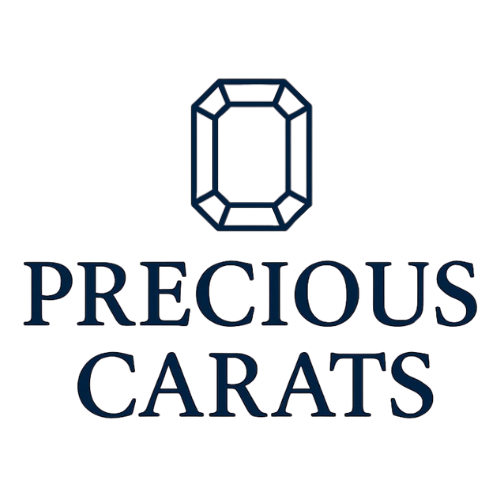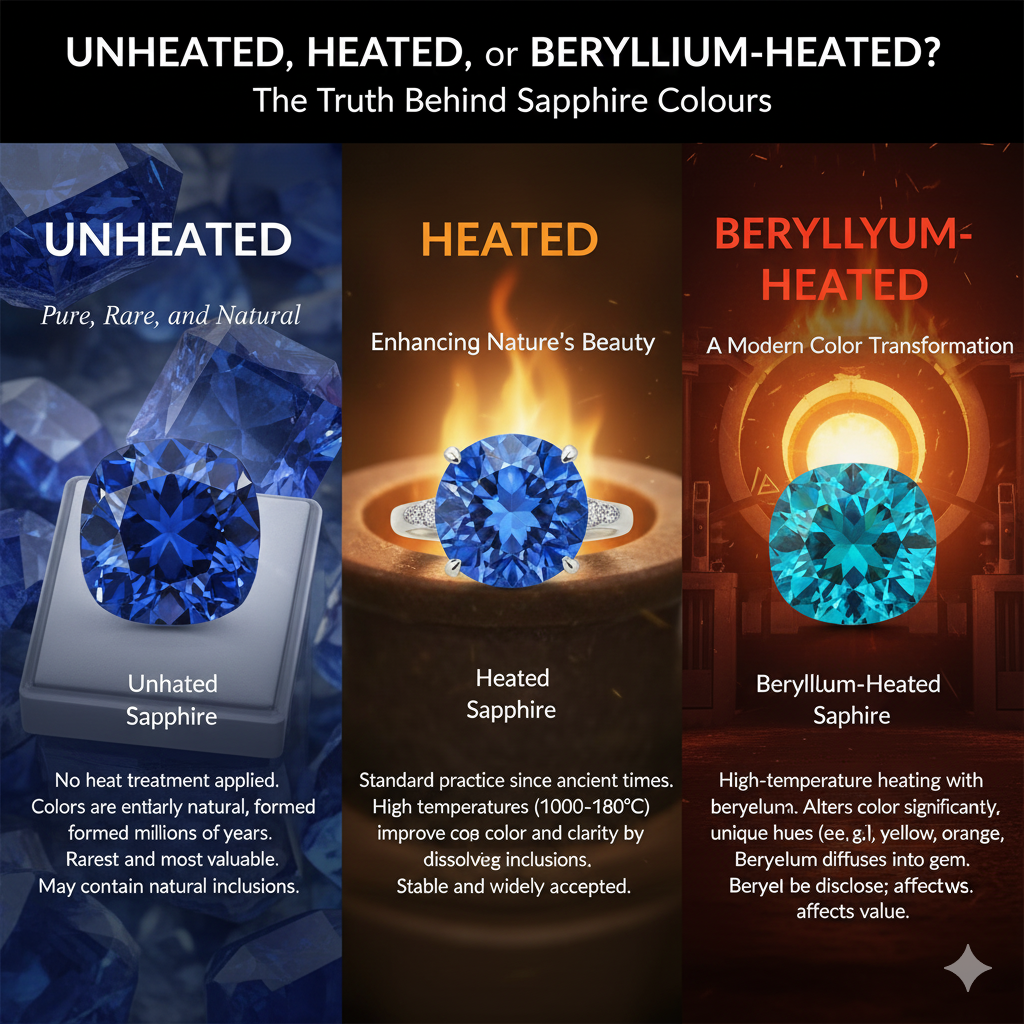Introduction: When Fire Shapes Beauty
Every sapphire tells a story of fire. Some of that fire comes from deep within the earth — a slow geological heat that shapes its colour across millions of years.
And some comes from a jeweller’s furnace — an intentional act to refine, reveal, or in certain cases, reinvent the stone.
Among all forms of sapphire enhancement, beryllium heat has remained the most debated. It is both a scientific triumph and a moral test for the gem trade.
At PreciousCarats, we believe in explaining every layer of truth behind the gems we curate — because beauty, when honestly told, only becomes more powerful.
- The Three Lives of a Sapphire
Before diving into the chemistry, let’s define the three broad categories every sapphire can fall into:
| Sapphire Type | Process | Description | Market Value Impact |
|---|---|---|---|
| Unheated Sapphire | None — natural colour as found | Untouched by human heat. The colour and clarity are completely natural. | Highest rarity and value |
| Heated Sapphire | Conventional heat at 1500–1750°C | Improves colour and removes silk (minute rutile inclusions). A long-accepted, stable treatment. | Widely accepted; moderate impact |
| Beryllium-Heated Sapphire | High-temperature diffusion at 1700–1900°C with Be compounds | Beryllium atoms penetrate deep into the crystal lattice, permanently altering colour. | Must be disclosed; commercial-grade value |
In short — heat can clarify, but beryllium can change.
The first respects what nature created; the second rewrites it.
- What Exactly Happens in a Beryllium Heat Treatment
At its core, beryllium heat is a diffusion process.
A sapphire is placed in a furnace with a compound that contains beryllium (Be) — often in powdered or flux form.
At extreme temperatures, the beryllium atoms become mobile and start migrating into the sapphire’s crystal lattice.
Because Be is a very small atom, it penetrates deeper than traditional diffusion elements like titanium or iron.
This process can transform the entire body colour of the gem — from a pale or brownish hue to vivid blues, yellows, or even the coveted pink-orange “padparadscha” tones.
Scientists at GIA and AIGS have observed that beryllium diffusion can colour the entire stone, not just the surface.
The result: a visually stunning sapphire, but one whose chemical signature no longer matches natural geological formation.
- A Brief History of Beryllium in Sapphires
The beryllium story began in the early 2000s.
Traders in Thailand started producing sapphires of extraordinary orange and pinkish-orange hues.
These stones flooded the global market, often sold as “natural padparadscha sapphires.”
However, gem labs soon discovered that these were not natural colourations, but the result of beryllium diffusion.
The discovery triggered an industry-wide reckoning.
For the first time, a treatment could completely change a sapphire’s identity in a way invisible to standard microscopes.
What had seemed like a miracle of colour was, in fact, a product of high-temperature chemistry.
Since then, the term “Be-treated sapphire” has become a permanent part of gemological vocabulary.
- Heat, Nature, and the Fine Line Between Enhancement and Alteration
All gemstones undergo some form of transformation — from their volcanic origin to the hands of a cutter.
Traditional heat treatment simply mimics what nature might have completed underground over millions of years.
It removes unwanted cloudiness and deepens natural colour, but doesn’t fundamentally change the stone’s elemental structure.
Beryllium heating, however, crosses that boundary.
It introduces a foreign element that never existed in the crystal originally.
The result may be permanent and beautiful, but it is no longer the sapphire nature made — it’s a sapphire nature modified.
The question then becomes one of philosophy:
Is beauty still authentic when it has been re-engineered?
At PreciousCarats, we believe authenticity is defined not by purity alone, but by transparency — the honesty with which a gem’s story is told.
- How to Identify Beryllium Diffusion
Detecting beryllium isn’t simple — it’s invisible to the naked eye and even to most standard gem scopes.
Only advanced laboratory analysis can confirm it.
- a) Laboratory Detection
Techniques like SIMS (Secondary Ion Mass Spectrometry) and LA-ICP-MS (Laser Ablation Inductively Coupled Plasma Mass Spectrometry) are used by premier labs such as GIA, Gübelin, and Lotus Gemology.
These tools can measure trace beryllium concentrations deep inside the crystal.
A lab report will typically say:
“Evidence of beryllium diffusion present.”
or
“Beryllium heat treatment detected.”
- b) Microscopic Indicators
In some cases, gemologists may notice:
- Altered inclusion halos or partially melted crystals
- Facet-related colour zoning instead of natural growth zoning
- “Flux fingerprints” caused by the heating medium
However, these are not fool-proof.
A professional laboratory certificate remains the only reliable confirmation.
- Why the Trade Uses Beryllium
The motivation is purely economic.
Large quantities of pale, brownish, or off-colour sapphire rough exist in the market.
Through beryllium diffusion, that material can be turned into saleable, vividly coloured stones at a fraction of the price of natural equivalents.
For example:
- A 5-carat pale yellow sapphire worth ₹3,000 per carat can be turned into a deep golden gem that looks like a ₹50,000 per carat piece.
- After treatment, it’s visually indistinguishable to the untrained eye.
This process has helped expand the supply of bright sapphires for mass jewellery.
However, it has also blurred the boundaries between natural and modified gems, creating confusion for end buyers.
- The Market Perception and Price Gap
| Treatment Type | Market Acceptance | Typical Price Range | Buyer Segment |
|---|---|---|---|
| Unheated | Most valued by collectors | ₹50,000 – ₹10,00,000 +/ct depending on origin and quality | Connoisseurs, investors |
| Heated (standard) | Accepted in trade, disclosed | ₹10,000 – ₹60,000 /ct | Regular fine-jewellery buyers |
| Beryllium-Heated | Accepted only with clear disclosure | ₹3,000 – ₹15,000 /ct | Mass-market, commercial jewellery |
Even though the colour may look similar, the value differential is dramatic.
For long-term value retention or astrological use, unheated or standard-heated stones remain the preferred choice.
- How to Protect Yourself as a Buyer
- a) Always Ask for Certification
Look for credible gem-testing institutions such as:
- GIA (Gemological Institute of America)
- IGI (International Gemological Institute)
- GTL (Gem Testing Laboratory, Jaipur)
- Lotus Gemology
- Gübelin / SSEF (for high-end stones)
The certificate should explicitly state the treatment type.
If it’s silent, ask for clarification.
- b) Understand Pricing Logic
If a sapphire’s colour seems “too perfect” for the price, there’s probably a reason.
Use market logic as your first filter.
- c) Prefer Transparent Sellers
Reputable dealers (like PreciousCarats) disclose treatment upfront and ask for a certificate from a third party lab .
We believe informed buyers create long-term relationships, not one-time transactions.
- For Astrological Buyers — Does Beryllium Matter Spiritually?
In Vedic tradition, gemstones are believed to channel planetary energies based on their purity and natural integrity.
A beryllium-heated sapphire, though physically stable, is not considered energetically natural.
Astrologers often recommend unheated or conventionally heated sapphires only for Saturn (Shani) purposes.
If your intent is astrological, choose certified unheated or “heat only” gems — preferably with lab mention:
“No evidence of diffusion or chemical treatment.”
It ensures that what you wear retains the full spiritual resonance nature intended.
- The Science of Colour Transformation
To appreciate why beryllium changes colour so profoundly, it helps to look at a bit of crystal chemistry.
Sapphire, or corundum (Al₂O₃), owes its colour to trace elements:
- Fe + Ti → Blue
- Fe only → Yellow
- Cr → Pink to Red
- Cr + Fe → Orange
When Be²⁺ ions diffuse in, they alter how iron and titanium ions bond within the lattice.
This can shift light absorption patterns dramatically — turning muddy hues into luminous tones.
In essence, beryllium behaves like a molecular artist, repainting the stone from within.
- Ethics and Disclosure — The Real Issue
The controversy around beryllium isn’t about science — it’s about honesty.
A beryllium-heated sapphire isn’t “fake”; it’s modified.
The problem arises when such stones are sold as “natural unheated” or “rare padparadscha.”
The gem world thrives on trust.
Every PreciousCarats gem includes its origin, treatment, and certification disclosure — because beauty should never depend on omission.
The difference between a jewel and a deception is often just one missing sentence on a certificate.
- Industry Standards and Regulation
Today, most major labs follow CIBJO and LMHC guidelines, which require:
- Explicit mention of “Beryllium diffusion treatment detected”
- Or “Evidence of diffusion extending deep into the stone”
Many countries’ consumer protection laws treat non-disclosure of treatments as misrepresentation.
In India too, the Bureau of Indian Standards (BIS) encourages jewellers to disclose all enhancements clearly.
The industry now recognizes two truths:
- Beryllium heat is permanent and stable, but
- It must be truthfully declared at every point in the supply chain.
- PreciousCarats’ Policy on Beryllium Heat
We handle gems across all quality tiers — from daily-wear Navratna stones to museum-grade collector pieces.
Our internal classification follows a transparent rule:
| Category | Type of Gem | Disclosure on Site |
|---|---|---|
| Sanctum | Ultra-rare, unheated, investment-grade gems | “No heat. No diffusion.” |
| Sacred Essentials | Astrological & accessible gems | “Heat only” or “Beryllium-heated” stated clearly if applicable |
This clarity ensures our customers always know what they’re buying — and why one gem may cost ten times another even if both shine equally to the eye.
- How PreciousCarats Tests and Classifies
Each gemstone in our vault undergoes:
- Independent laboratory certification
- Visual verification under microscope
- Cross-checking of report wording
We never list a gem unless its treatment type is 100% documented.
Our photographs, GemLightBox videos, and certificate scans are visible for every SKU.
If a gem has been beryllium-heated, it will say so in writing — quietly, without stigma, but with full honesty.
Because trust is a luxury too.
- The Future of Diffusion Treatments
Beryllium diffusion has changed the sapphire market forever.
It has made beautiful gems more accessible to a broader audience — but it has also raised the bar for disclosure and buyer education.
Emerging research now explores multi-element diffusion (using beryllium with titanium or chromium) and surface-only colour layering, which further complicate testing.
For collectors and jewellers, this means one thing:
Certification will only become more essential with time.
- The Philosophy of Fire
In a way, every sapphire owes its existence to heat — natural or human.
The question is not whether heat is wrong, but whether truth is told.
At PreciousCarats, we see each gemstone as a meeting point between nature’s patience and human curiosity.
Beryllium-heated sapphires belong to that story too — they are part of the grand experiment of beauty, where science learns to imitate the earth’s art.
But when a buyer holds a sapphire from our vault, we want them to know which fire shaped it — the earth’s, or man’s.

